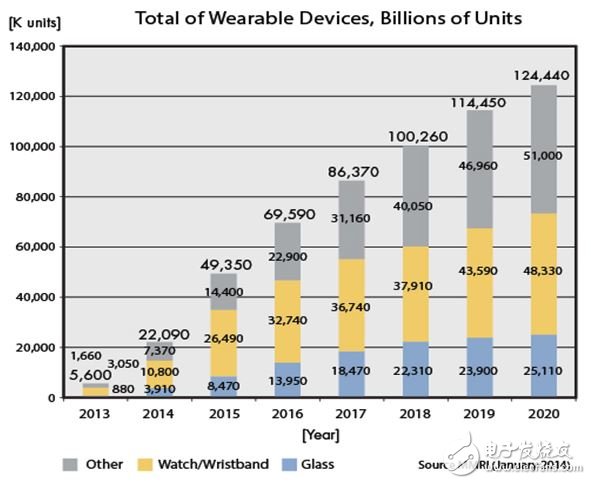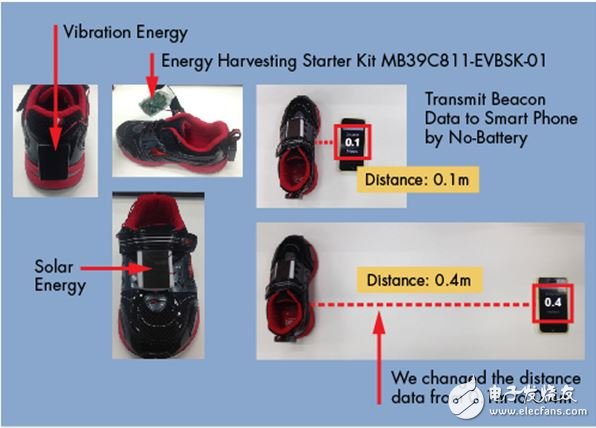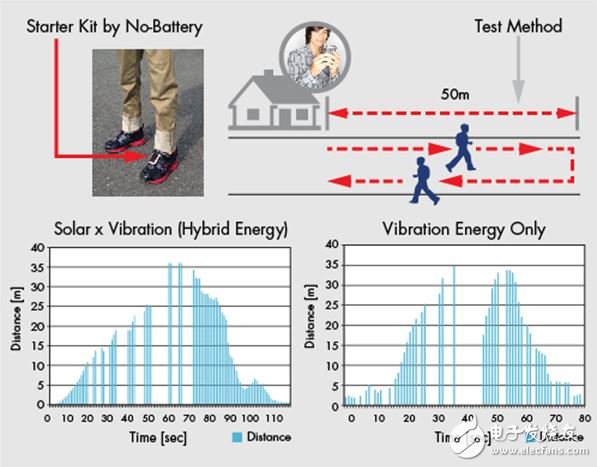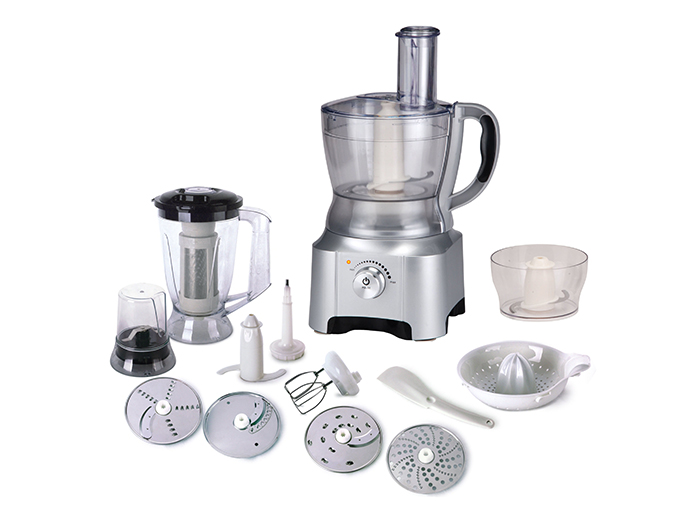In recent years, new wearable devices, such as smart watches and smart glasses, have been constantly appearing in our lives. To understand the potential of wearable device applications, we only need to look at the number of wearable devices in the global market – this number is expected to grow from 5.6 million in 2013 to 124 million in 2020 (see Figure 1). Several factors are driving this growth. In most developed countries, the smartphone market is almost saturated, and manufacturers have begun to develop devices that can create new trends, such as the ability to connect to wearable devices as peripheral devices. The emergence of the Internet of Things (IoT) has also driven this trend. At the same time, semiconductor technology has enabled these more powerful and smaller devices to be produced at higher speeds. Figure 1: The number of wearable devices will reach 124 million by 2020, and smart watches and smart glasses will account for nearly 60% of the total. 2/3 of the wearable devices are end devices that are worn on the body, such as watches and glasses, while the rest of the wearable devices can be attached to shoes, clothes or bags. In addition, the possibility of implanting the device in the human body and connecting it to the human brain is being explored. In the future, wearable devices are expected to turn the scenes described in science fiction movies into reality. Although the development potential of wearable devices is huge, there is still a big problem. How do we power these devices without having to constantly charge the batteries? The solution is for energy harvesting, and the Cypress development board gives us a convenient choice. Power problem Although the innovation of wearable devices is accelerating, the battery technology field is still lagging behind. In particular, battery life poses serious problems. Unlike smartphones, glasses, watches, shoes, clothes, and the like cannot be charged in our daily lives. If you need to recharge these items frequently, people will feel very troublesome. Wearables require a battery that lasts long enough to ensure that we don't have to take these devices down to charge, so our bodies are almost unaware of their existence. Wearable devices typically require small size and light weight. The problem is that batteries on the market today face almost the same problem, that is, the smaller the battery, the smaller the energy density. Semiconductors are still able to keep up with Moore's Law and accelerate the pace of miniaturization at a rate of 200% per year. At the same time, in the 20 years since the introduction of lithium-ion secondary batteries, battery technology has only increased the energy density per unit volume by about 350%, which is less than 10% of the semiconductor miniaturization speed. If we have indeed confirmed that the advancement of battery technology is too slow, then we naturally have to find other solutions. This prompted us to consider a new technology called energy harvesting that has recently emerged. Energy harvesting involves collecting or collecting a small amount of environmentally friendly energy generated by energy sources around us (such as light, vibration, and heat) and converting it into electricity. We need to investigate whether this technology can provide us with a way to extend the battery life of wearable devices and even run the wearable device without a battery. It should be noted that energy harvesting technology is still far from mature. For example, it does not operate a watch-type wearable device without a battery. Still, it is an ideal solution for devices such as those used to transfer simple data from sensors to smartphones to record daily activities. Accelerate the application of energy harvesting technology Energy harvesting technology provides a promising power solution for many wearable devices. However, many engineers are not familiar with the technology, and the implementation of the technology can take a lot of valuable time, and the development team can use this time to enhance the core value proposition of its products. Cypress's MB39C811-EVBSK-02 Bluetooth Smart Beacon Starter Kit provides embedded engineers with a simple and quick option for energy harvesting. The kit includes the Cypress MB39C811 Power Management Integrated Circuit (IC) as a standard feature, as well as a Bluetooth Smart module that allows program rewriting in the user area and a solar panel for operation in the inspection room (see Figure 2). ). The MB39C811 is a high efficiency step-down DC/DC converter IC that integrates a low power, full-wave rectifier bridge and a comparator system. When connected to a separately provided vibration collector, such as a piezoelectric device, the starter kit can operate in a hybrid mode that uses vibrational energy and room light energy. Figure 2: Cypress MB39C811-EVBSK-02 The Bluetooth Smart Beacon Starter Kit features a high efficiency step-down DC/DC converter specifically for piezoelectric or solar cell energy harvesters. The kit also includes a circuit board with pre-written sample programs for operating Bluetooth smart beacons that are placed under office lighting conditions (typically 400 to 500 lux on a desk). The Bluetooth Smart Beacon packet will be automatically transferred to the smartphone using only the energy obtained from its solar panel (see Figure 3). In the 500 lux environment, the transmission interval is set to 1 second. Figure 3: When the solar panel is illuminated by 500 lux, the starter kit automatically transmits the Bluetooth Smart Beacon packet to the smartphone. Smart shoes: energy harvesting during exercise To test the kit, we applied energy harvesting technology to a wearable proximity sensor designed to transmit a child's position. We embed the board and power generation unit into the children's shoes and let our test objects move 50 meters back and forth to test whether the position data can be obtained. First, the intensity of the electric field is measured using a smartphone based on the Received Signal Strength Indication (RSSI) used in accordance with the iBeacon standard. Then, calculate the distance r between the smartphone and the child using the following formula: Among them, RSSI is the reception intensity (fixed value) at 1 meter, and Tx is the actual reception intensity (measured value). We chose an electromagnetic induction type vibration acquisition device so that the vibration generated by the motion of the test object is converted into electrical energy for transmitting radio waves (see Fig. 4). In addition, the design uses solar panels to allow the device to operate under conditions of vibration or light. With this hybrid design, the position of the child can be detected even when the child is not moving. Figure 4: The starter kit enables position sensors mounted on children's shoes to be powered by energy harvested from vibration and solar energy resources. The results show that the device successfully passed Bluetooth? The SmartBeacon transfers the data to the smartphone (see Figure 5). The vibration is generated by the vibrational energy generated by the child's movement, and the sensor can detect and transmit the position of the child. Experiments like this example are expected to help us solve the battery problems associated with wearable devices using the energy harvesting technology provided by Cypress. Figure 5: In the test, the test object walked 50m away from the receiver and then returned. The distance versus time shows the effectiveness of the sensor operating with photovoltaic and vibrational energy combined (left) or separately powered by vibration energy (right). Energy harvesting technology offers great promise for us to address the challenges of the wearable device market. Devices for real-life energy harvesting, including Cypress power management ICs, are being developed in various fields. It is primarily intended for battery-free wireless sensor terminals implemented for similar applications such as machine-to-machine (M2M) communications and implemented as part of the Industrial Internet of Things (IoT). Developers and manufacturers should wait and see what the company is about to release. Similarly, the company plans to offer power management ICs and low-power microcontrollers (MCUs) specifically designed to address battery issues in the wearables field in the near future.
Food Processors are multifunction kitchen appliances that can process food, vegetables into various desired states by matching different accessories. The more accessories, the more function of the food processors have. Usually, food processors including Plastic Jar Food Processors and Glass Jar Food Processors. According to the function, food processors can be divided into 4 in 1, 7 in 1, 10 in 1 and 15 in 1 food processors.
Generally speaking, food processors have the following functions: Blender, Juicer, Filter, Grinder, Mixing, Chopping, Citrus, Dough making, Egg whisk, Slice, Shred, Mash, Frech fries making, etc.
Food Processors Food Processors,Electric Food Processor,Mini Food Processor,Multi-Function Food Processor Flying Electronic Co., Ltd , https://www.flyingelectronic.com




